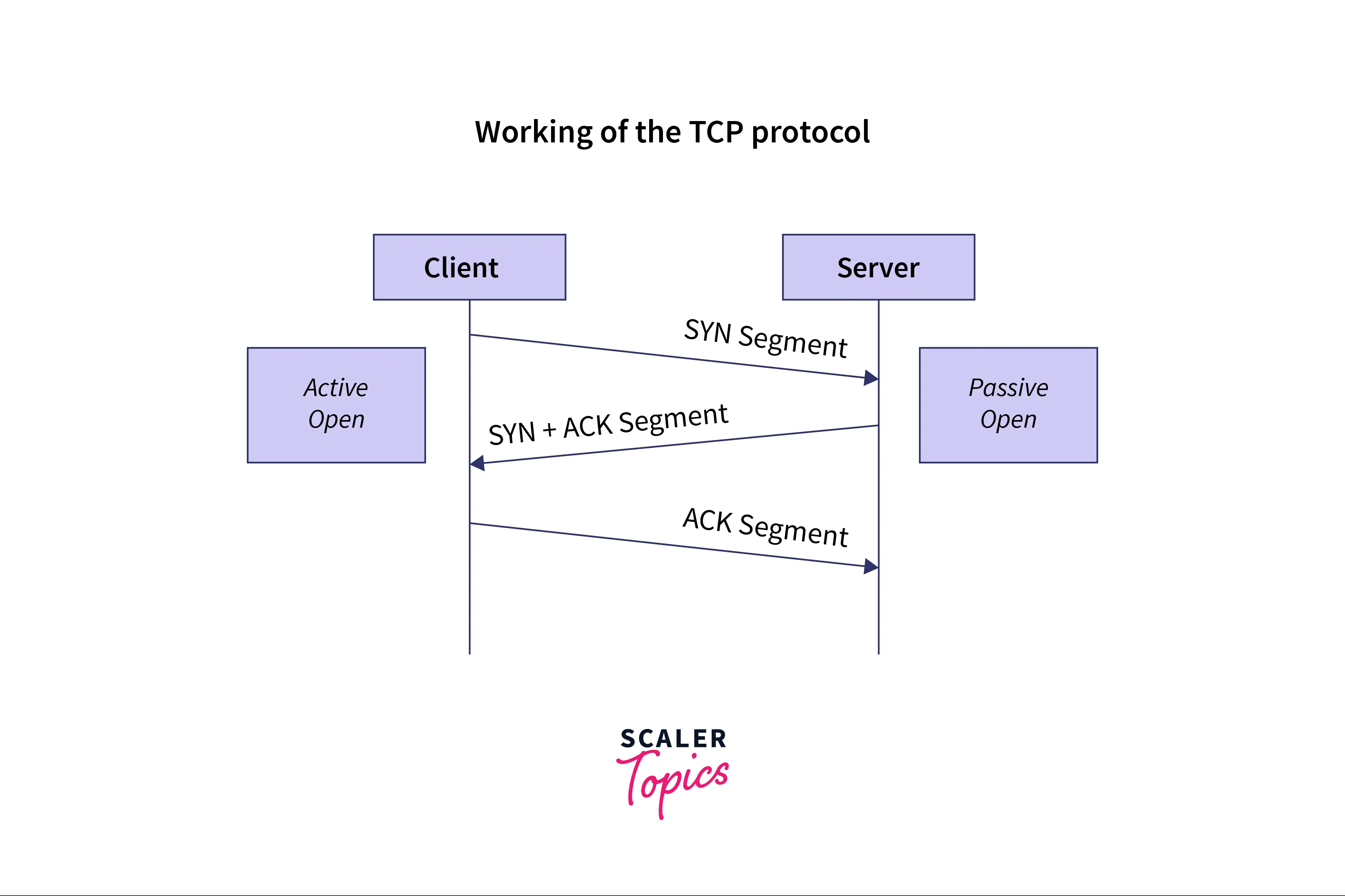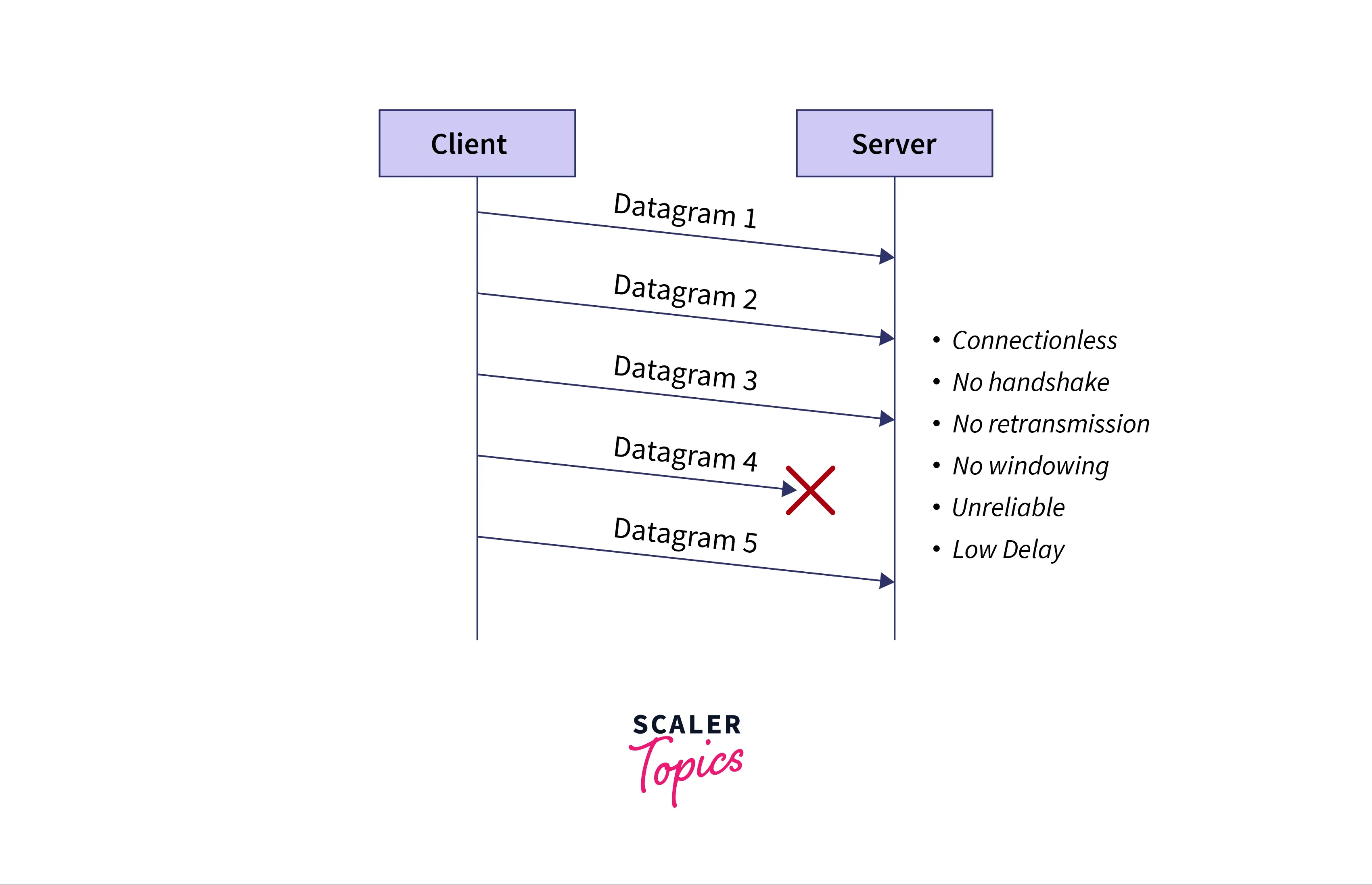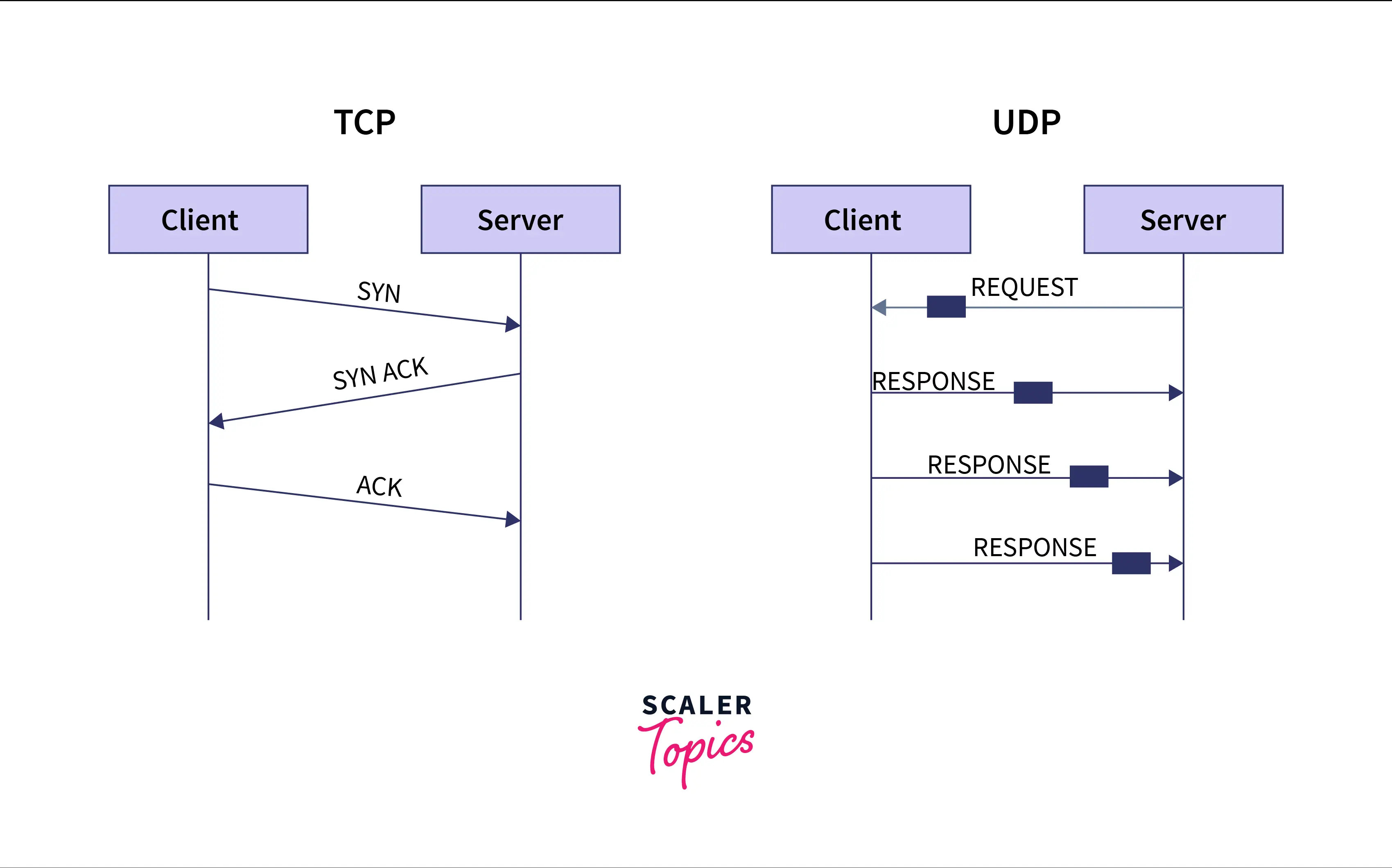The Internet Protocol (IP) is a collection of protocols used on the Internet for addressing and routing data. Every device has an IP address, which uniquely identifies it and allows it to communicate and share data with other internet-connected devices. TCP and UDP are the most widely used internet protocols. TCP stands for Transmission Control Protocol, and UDP is for User Datagram Protocol. TCP is a connection-oriented protocol whereas, UDP is a connectionless protocol.
Using UDP, several messages are transmitted as packets in chunks. The speed difference between TCP and UDP is significant, with TCP being slower than UDP.
What is TCP?
TCP/IP is an abbreviation for Transmission Control Protocol/Internet Protocol.
It allows you to specify how a certain computer should be linked to the internet and how data should be sent between them. When many computer networks are linked, it aids in the creation of a virtual network.
It is intended to transfer packets across the internet and enable the successful transmission of data and messages through networks. TCP is one of the most widely used protocols in digital network communications, ensuring end-to-end data transmission.
TCP is adaptable and scalable, which means that new protocols may be added to it and it will collaborate.
TCP arranges data so that it may be transferred between a server and a client. It ensures the integrity of data transmitted across a network. TCP creates a connection between a source and its client before transmitting data, and it guarantees that the connection stays active until communication occurs.
It is intended to divide a communication, such as an email, into data packets for the message to reach its destination successfully and as rapidly as feasible while guaranteeing data integrity throughout the process.
A three-way handshake, which is the act of establishing and acknowledging a connection, is used to create a TCP connection. Data transfer can commence after the link is established. The link is deactivated after transmission by shutting all existing virtual circuits.

Features of TCP
- In TCP, the receiver always responds to the sender either positive or negative acknowledgment of the data packet which makes it reliable.
- TCP assures that data arrives at its destination in the same order in which it was sent.
- TCP requires that a connection be established between two remote sites.
- TCP has an error-checking and recovery mechanism built-in.
- TCP allows for end-to-end communication.
- TCP handles flow control and service quality.
- TCP operates in a point-to-point Client/Server manner.
- TCP is a full-duplex server, which means it can act as both a receiver and a transmitter.
What is UDP?
UDP is an abbreviation for User Datagram Protocol .
The User Datagram Protocol, or UDP, is an Internet communication protocol that is used for time-critical transfers like video stream and DNS lookups. It saves time by avoiding the formal establishment of a connection before data is exchanged. This allows data to be transported fast, but it also increases the risk of packets being lost in transit, which may be exploited.
UDP straightforwardly does this: it transmits packets (data transmission units) immediately to a destination computer without first establishing a connection, identifying the sequence of these packets, or verifying that they arrived as intended. UDP packets are known as ‘datagrams.
To ensure dependability, ordering, and data integrity, UDP adopts a transmission paradigm without implied handshake conversations. As a result, UDP delivers a shaky service, with datagrams arriving out of order, appearing duplicated, or disappear without warning. UDP implies that error checking and repair are either unnecessary or accomplished at the application level.
UDP is widely employed in time-sensitive communications where losing packets sometimes is preferable to waiting. This protocol is used to send audio and video communication since they are both time-sensitive and engineered to withstand some loss. UDP is an excellent choice for online gaming. DNS servers, meanwhile, employ UDP since they must be quick and efficient.

Features of UDP
- When the acknowledgment of data is not important, UDP is utilized.
- UDP is a useful protocol for one-way data flows which means the data has one, and only one way to be transferred to other parts of the application.
- UDP is a basic protocol that is well-suited for a simple connectionless communication model with a minimum of protocol mechanisms.
- UDP is a connectionless protocol.
- UDP does not include a means for the control of the entry of data packets into the network.
- UDP does not guarantee that data will be delivered in the order that it was requested.
- UDP is a stateless protocol in simple terms UDP is a communication protocol in which the receiver must not retain session state from previous requests.
- UDP is a good protocol for streaming applications like VoIP and multimedia streaming like Netflix, Hotstar, etc.
Difference Between TCP and UDP
TCP is a connection-oriented protocol, whereas UDP is a connectionless protocol. TCP is slower than UDP, which is one of the main differences between the two protocols.
Overall, UDP is a much quicker, simpler, and more efficient protocol, yet, only TCP allows for the retransmission of lost data packets.

| Parameters | TCP | UDP |
|---|---|---|
| Full Form | Transmission Control Protocol | User Datagram Protocol |
| Connection Type | TCP is a connection-oriented protocol. | UDP is a connectionless protocol. |
| Speed | TCP is comparatively slower than UDP. | UDP is faster, simpler, and more efficient than TCP. |
| Header Size | 20 bytes | 8 bytes |
| Reliability | Reliable | Unreliable |
| Ordered Delivery | Yes | No |
| Congestion Control | Yes | No |
| Data Sequencing | The Transmission Control Protocol has a function that allows data to be sequenced (TCP). This means that packets arrive at the recipient in the correct order. | Unavailable since UDP uses destination and source IP to identify the right packet. |
| Retransmission of Data | Retransmission of lost packets are possible. | Not possible because in UDP if the packet is dropped neither the sender nor the reciever is informed about it. |
| Broadcasting | Not available in TCP because in case of TCP communication is done exactly between two servers i.e. host server and single recipient server. | UDP supports Broadcasting. |
| Handshake Protocols | Handshakes Protocols like SYN, SYN-ACK, ACK are available. | No Handshake protocols as it is connectionless. |
| Method of Transfer | TCP messages are sent from one computer to another through the internet. | It is not connection-based, so one program can send lots of packets to another. |
| Uses | TCP is generally used in different netowrk layer protocols like HTTPS, HTTP, SMTP, POP, FTP, etc. | UDP is used in different Video conferencing apps like Zoom, streaming services like Netflix, DNS, VoIP, etc. |
| Error Handling | Retransmission of lost packets. | Dropping of lost packets. |
| Examples | File transfer, web browsing, email. | Streaming media, online gaming, VoIP. |
Applications of TCP
- Simple Mail Transfer Protocol – The TCP/IP standard protocol for transmitting electronic mail messages from one machine to another is Simple Mail Transfer Protocol.
- TELNET – TELNET is a simple remote desktop protocol included in the TCP/IP protocol family. TELNET allows a user at one site to connect to a login server at another through a TCP connection.
- Rlogin – A remote login service, rlogin, that supports trustworthy hosts is included in the operating system derived from BSD UNIX. It enables system administrators to select a collection of machines that share login names and file access safeguards, as well as to establish equivalences between user logins.
- File Transfer Protocol – File transmission is one of the most commonly utilized TCP/IP applications, accounting for a large portion of network traffic.
- Trivial File Transfer Protocol – The TCP/IP suite includes a second file transfer protocol that provides a low-cost, uncomplicated service. The Trivial File Transfer Protocol (TFTP) is designed for applications that do not require sophisticated interactions between the client and the server.
Applications of UDP
- UDP can be utilized in scenarios where lossless data delivery is required.
- UDP is a good network protocol for applications where perceived latency is crucial, such as gaming, voice and video communications. These examples can sustain some data loss while maintaining perceived quality.
- UDP can also be utilized for applications that rely on the reliable exchange of information, but these programs should have their own techniques for responding to packets.
- Because it provides packet switching, UDP can also be used for multicasting. UDP is also used in several routing update protocols, such as the Routing Information Protocol.
- UDP can be used in applications where speed is more important than reliability.
Advantages and Disadvantages of TCP
Advantages of TCP
- It is an industry–standard paradigm that can be used effectively in real–world networking challenges.
- It enables cross-platform communication among disparate networks.
- TCP protocol is public in nature as it doesn’t not held by any specific institute, it can be utilized by any individual or organization.
- It is a client-server design that is scalable. This enables networks to be introduced without interfering with existing services.
- It gives each machine on the network an IP address, allowing each device to be identified via the network. It assigns a domain name to each site. Its services include name and address resolving.
- TCP ensures reliable data delivery while UDP ensures unreliable data delivery. TCP guarantees that data is delivered in the correct order and without errors. This is achieved through a number of mechanisms, such as acknowledgments, retransmissions, and flow control.
- TCP establishes a connection between the sender and receiver before data is transmitted. This allows for features such as flow control and congestion control.
- TCP ensures that data is delivered in the same order in which it was sent. This is important for applications that rely on the order of data, such as file transfers and streaming media.
Disadvantages of TCP
- It cannot represent any other protocol stack save the TCP/IP suite.
- It does not distinguish between the ideas of services, interfaces, and protocols.
- It makes no distinction between the data link and the physical layers, which serve quite different purposes.
- It’s not optimized for local area network as it was primarily built for Wide Area Network.
- TCP’s reliability mechanisms add overhead, which can make it slower than UDP. This is especially noticeable for small data transfers.
- TCP’s reliability mechanisms can introduce latency, which can make it unsuitable for real-time applications such as voice and video over IP (VoIP).
Advantages and Disadvantages of UDP
Advantages of UDP
- It employs a small packet size with a small header (8 bytes) as a result the UDP protocol requires less time and memory to process the packet.
- It does not necessitate the establishment and maintenance of a connection. Also, the absence of an acknowledgment field in UDP makes it faster.
- It employs checksums with all packets to primarily detect errors followed by other uses like data integration, etc.
- UDP is a simpler protocol than TCP, which makes it faster.
- UDP’s lack of reliability mechanisms makes it suitable for real-time applications such as VoIP.
Disadvantages of UDP
- It is an unstable and connectionless transport protocol.
- It makes no use of error control. As a result, if UDP identifies an error in a received packet, it discreetly discards the packet and there is no recovery for the lost packet like in the case of TCP protocol.
- There is no traffic regulation. As a result, a large number of people sending significant amounts of data via UDP might generate congestion, and no one can do anything about it.
- There is no flow control and no data acknowledgment.
- Only the application layer is responsible for error recovery. As a result, applications can simply ask the user to send the message again.
- Routers can be irresponsible when it comes to UDP. They do not retransmit a UDP datagram after it has collided, and they frequently trash UDP packets before TCP packets.
Conclusion
- The TCP protocol is a connection-oriented protocol, whereas the UDP protocol is a connectionless protocol.
- TCP guarantees that a stream of bytes is sent in a reliable and orderly manner from the user to the server or vice versa. UDP isn’t designed for end-to-end communication, and it doesn’t confirm the receiver’s readiness.
- TCP’s speed is slower, whereas UDP’s speed is faster.
- TCP performs error checking as well as error recovery, whereas UDP does error checking but discards erroneous packets.
- TCP contains acknowledgment segments, whereas UDP does not have any.
- TCP employs handshake protocols such as SYN, SYN-ACK, and ACK, but UDP employs no handshake protocols.
- Overall, UDP is a much quicker, simpler, and more efficient protocol, nonetheless, only TCP allows for the retransmission of lost data packets.
- When comparing the TCP and UDP protocols, TCP is heavier while UDP is lighter.